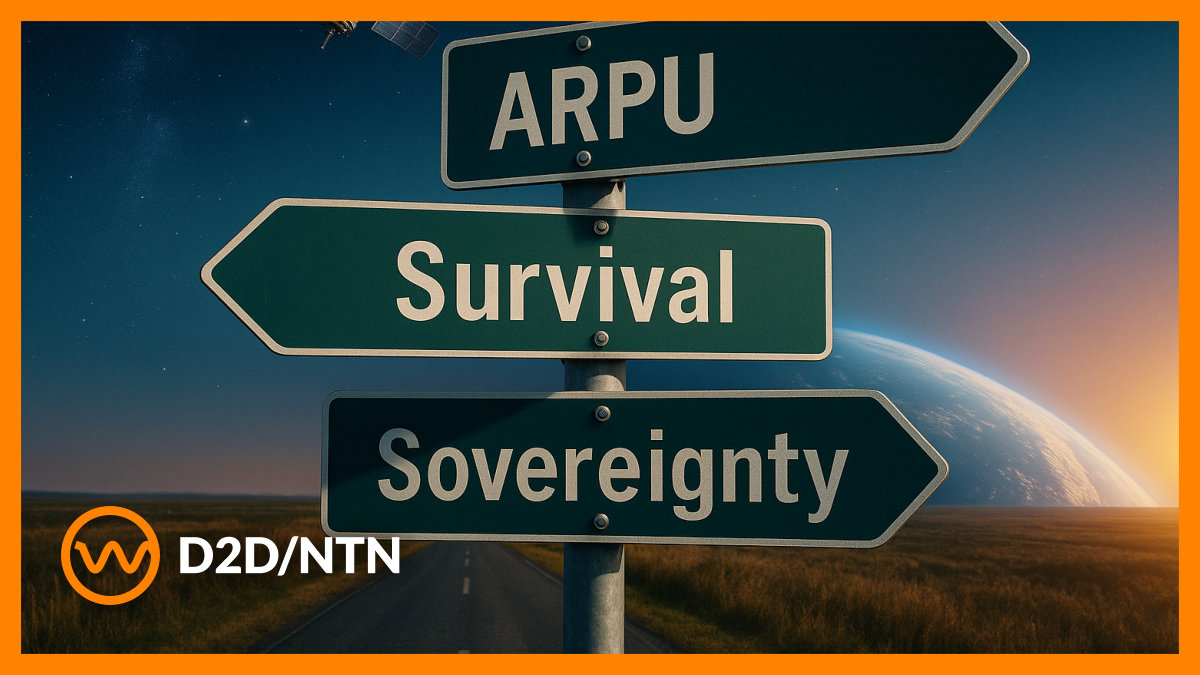ORBITAL WHISPERS

TL;DR
NTN moved from slideware to system behavior.
Telcos get ARPU and churn insulation, satellite operators get survival through standards and then face wholesale pricing pressure, governments get leverage through lawful access, spectrum, and alerting.
The strategic fight is who controls the policy knobs that decide when a phone prefers space, on what terms, and under which laws.

NTN at the Crossroads
ARPU, Survival, Sovereignty
There are three reasons the industry is suddenly fluent in non-terrestrial networks. Telcos see a new line item, satellites see a lifeline, governments see control. The same technology unlocks all three, with very different incentives. If you run a network, a satellite fleet, or a ministry, this is your moment to make decisions that shape five to ten years of leverage.
3GPP Release 17 placed satellite access into the 5G rulebook. It defined how ordinary devices find and talk to space, how they pre-compensate Doppler and timing so the uplink lands where the network expects it, and it gave everyone a common vocabulary for NR-NTN and IoT-NTN.
NR-NTN is shorthand for New Radio Non-Terrestrial Network. It is basically 5G NR adapted for satellites. That means unmodified 5G smartphones, tablets, or other NR devices can talk to a satellite the same way they would to a terrestrial base station, with extra compensation for Doppler shift, large round-trip delays, and moving cells. Typical targets are voice, messaging, and broadband-class data.
IoT-NTN is the corresponding standard for narrowband use. It adapts NB-IoT and eMTC (LTE-M) to satellites. This is about low-power devices, sensors, and trackers. The focus is extremely long battery life, tolerance of small antennas, and the ability to wake up infrequently and send short bursts of data. IoT-NTN is what makes global asset tracking, smart meters in remote areas, or agricultural sensors feasible without bespoke satellite modems.
3GPP Release 18 tightened mobility and coverage behavior and paved the way for Release 19, which introduces more capable payloads and idle-mode mobility between terrestrial and space cells. In FR1, two handset-friendly bands are on the table, L-band n255 and S-band n256, which align with MSS heritage and realistic smartphone antennas.
I’m a Telco
From the telco view the pitch is simple. You can price satellite messaging and basic data as an add-on and call it growth. T-Mobile in the United States already shows how to fold it into tariffs. Starlink lists text as live, data and IoT next, voice later. This is not speculative hype but pricing in public. Yet the true return is not the few extra dollars.
The more significant value lies in churn reduction in rural and travel cohorts, the improvement in perceived reliability after the first wildfire or flood, and the drop in customer support time spent on “no service” calls.
Coverage immunity sells once, but when every carrier in your market signs a different space partner parity returns within months. The first mover harvests a year of reputation while the late entrant pays in lost trust.
Coverage symmetry brings another shift. When satellite fills the last five percent for everyone the old “we have more dots on the map” pitch loses bite. Differentiation moves to the quality of integration, how elegantly policy works across orbits, how satellite bearers behave under congestion, how roaming and billing feel inside the core. That is product design, not spectrum ownership.
At the same time handset makers have slipped into the role of channel. Apple taught users that green bubbles can still reach orbit when towers fail. The expectation transfers to your brand whether or not your logo sits on the sky. Customer education no longer belongs entirely to you.
I’m Sat-Op
For satellite operators the story is even starker. Being written into the standards was survival. Without it handset makers and mobile cores would never support them at scale. The first demonstrations from AST SpaceMobile and Starlink proved that unmodified phones can connect and that operators are willing to sign.
These proofs turned investor interest into long term commitments and pushed device makers to keep NTN on the roadmap. The danger is clear. Once access is standardized the MNO brand fronts the customer and the satellite becomes wholesale capacity. That road ends in commodity pricing.
The escape route is differentiation further up the stack. Governments will pay for cell broadcast integration and priority slices for first responders. Energy companies and shippers will pay for deterministic quality tiers. Regenerative payloads that host parts of the RAN on-orbit allow smarter traffic management and caching without constant feeder visibility, which gives leverage that a ground-only network cannot replace.
We are Gov – Resistance is Futile
For governments the issue is control. Critical communications roaming to space still carry interception and retention obligations. The framework is there because NTN lives inside 5G system specs, but execution across borders and vendors is fragile. National emergency messaging and cell-broadcast frameworks must assume satellite bearers. They must be tested in peacetime, not discovered wanting during a blackout.
Spectrum decisions matter as well. Global meetings opened formal studies on MSS allocations that sit directly under direct-to-device. If domestic control over D2D is the goal, clarity on which parts of L and S band are viable and how they coordinate with incumbents must be settled.
Events in Ukraine brought the point home. When terrestrial infrastructure became a wartime target Kyivstar prepared to launch direct-to-cell messaging with Starlink. That choice came not from marketing decks but from destroyed towers. Regulators with civil defense responsibilities should not wait for their own catastrophe before pre-clearing the rails. Whoever defines how D2D works in a jurisdiction will decide which devices stay connected when towers go dark.
It is tempting to believe this is all solved by more satellites and more spectrum, yet physics sets boundaries. Handhelds are small radios. L-band and S-band exist in the standards because they are the frequencies a phone can realistically use with a low-gain antenna. Anything higher needs compromises.
You are Consumer
The first consumer experiences will be messaging, low rate data and buffered applications, not streaming video. Doppler and timing shifts are not marketing trivia but the difference between a working connection and a dead battery.
Devices must constantly adjust for moving satellites, which drains power and requires a clear sky view. Even mobility itself looks different. In LEO the cell moves over the user rather than the other way around. Without proper handover and paging rules you get drops that masquerade as bugs.
The present is already tangible. Apple’s service is live on recent iPhones. Operators are beginning to fold satellite messaging into plans. AT&T and AST demonstrated service over AT&T spectrum and formalized the next steps. Vodafone and AST will roll out direct-to-device in Europe in 2026. Kyivstar is preparing to offer Starlink messaging by year end with voice and broadband targeted later.
Release 18 has been frozen and defines how these systems behave, while Release 19 is shaping regenerative payload assumptions and mobility refinements. Procurement language should now specify which release features you require rather than simply writing NTN as a buzzword.
What’s Next
The risk not priced correctly is what happens once every carrier and every government can claim the same last five percent. Coverage ceases to be differentiation.
Telcos that tick the box and move on will end up competing on price again.
Satellite operators that sell nothing but wholesale coverage will be pushed to the margins.
Governments that treat it as novelty will discover their alert systems rely on private interconnects they never tested.
The only way forward is to treat NTN as policy and product at once. Whoever controls when and how a device uses space, and under which legal terms, controls the customer experience and the national narrative when networks fail.
The foundation is standardized, the first services are live, and the next decisions will decide whether:
you own that control point,
rent it,
or discover that it belongs to someone else.
Comments

Restricted Content
This content is sealed tighter than a procurement meeting on Friday at 4 p.m. To get in, you’ll need clearance, ideally accompanied by a badge, a budget code, and the ability to nod through three acronyms you don’t understand.
Push the button. You know you want to.
Or don’t. We’re not here to tell you how to live.


Join the discussion
Please log in to comment.